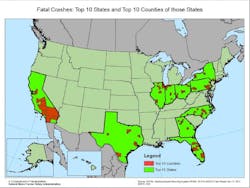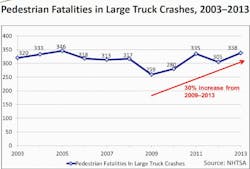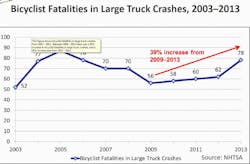FMCSA discusses large truck crash fatalities, calls for police training
Chances are you've heard it said that when heavy trucks and cars collide, the truck always wins. That's even more the case when it's a collision involving a pedestrian or bicyclist, and in a Nov. 18 webinar, the Federal Motor Carrier Safety Administration (FMCSA) talked findings from its latest collision fatalities study and encouraged police to train on traffic stops of large trucks and buses.
Key in that study — which includes latest-available data up through 2013 — is that commercial vehicles are disproportionately involved in crashes on the road. Heavy trucks and buses accounted for about 4% of registered vehicles and 9% of total miles driven, but were involved in 13% of accidents and 13% of overall traffic fatalities, according to FMCSA's data for 2013.
"Trucks and buses are overrepresented in traffic crashes," said FMCSA Chief Safety Officer Jack Van Steenburg. "We have to pay attention to this detail." However, as participants heard, what's causing the crashes is critical to understanding the data and taking action to reduce collisions.
The webinar was part of U.S. Transportation Sec. Anthony Foxx's "Mayors' Challenge for Safer People and Safer Streets" calling on city leaders to advance roadway safety for bicyclists and pedestrians. Some 240 cities in 45 states have joined that initiative, officials noted during the webinar.
In that vein, Jeff James, FMCSA division administrator for Washington state, presented some findings from a large vehicle/non-motorized vehicle traffic safety assessment that took place in May examining some particular roads in Seattle. With everyone from city officials to truckers, cyclists and walking and jogging enthusiasts involved, he said all parties agreed on one thing to make roads safer: separate motorized and non-motorized vehicle traffic.
And where it's not possible to actually separate the two, participants suggested better markings of designated paths for motor vehicle traffic and foot/bicycle traffic with things like bright or reflective paint, James noted.
Van Steenburg provided an overview of accident and fatalities data compiled by the National Highway Traffic Safety Administration (NHTSA). In 2013, he told listeners, 3,806 crashes across the United States involving a large truck or bus killed 4,251 people. Of those fatalities, however — largely due to simple physics, since commercial vehicles are the biggest dog in the fight, so to speak — only 739 deaths, or 17%, were of large truck or bus occupants.
But 3,512 of the crash fatalities were people in passenger vehicles or motorcyclists, bicyclists or pedestrians. In terms of those last two, there were more deaths of those on foot: 338 pedestrians and 78 bicyclists were killed in 2013, according to FMCSA.
Van Steenburg noted that crashes with fatalities were concentrated in 10 states, those being California, Texas, Florida, Georgia, North Carolina and a string of states from Illinois, Indiana, Ohio and Pennsylvania to New York.
"These 10 states account for 50% of the fatal crashes throughout the United States," Van Steenburg said, adding that FMCSA will look to focus some resources and safety improvement efforts there. "We're not considering vehicle miles traveled, we're considering people, folks — that's what this is all about is saving lives," he continued. "If we can just reduce crashes in these states by 10%, it would save over 200 lives during the next year."
Fatalities: drilling down
Van Steenburg explained that FMCSA analysts look more closely at the details surrounding crash fatalities, and that helps inform cities working to find ways to make roadways safer.
"Is alcohol or drugs involved? Where are these crashes occurring — are they occurring at intersections? Are they occurring in work zones? Are there lighting issues to be considered, clothing issues to be considered?" he told listeners. "These are some of the issues that we'll be tackling through the Mayors' Challenge."
Overall, there was a 30% increase in pedestrian fatalities in large truck crashes from 2009 to 2013 (from 259 to 338), and a 39% increase in bicyclist fatalities in large truck crashes over the same period (from 56 to 78). However, that information needs to be qualified: those increases follow a period of decline in both of those fatality types through 2009 such that the number of pedestrian and bicyclist fatalities in 2013 actually closely mirrors the numbers in 2004.
According to NHTSA data, pedestrian fatalities in large truck crashes across the country numbered 320 in 2003; 333 in 2004; 346 in 2005; 318 in 2006; 313 in 2007; 317 in 2008; 259 in 2009; 280 in 2010; 335 in 2011; 305 in 2012; and 338 in 2013. Bicyclist fatalities followed a similar pattern: in crashes involving large trucks, 52 cyclists died in 2003; 77 in 2004; 87 in 2005; 78 in 2006; 70 in 2007; 70 again in 2008; 56 in 2009; 58 in 2010; 60 in 2011; 62 in 2012; and 78 in 2013.
So what happened with that anomalous dip in 2009? FMCSA attributes that to the Great Recession — commerce took a dive circa 2008, and it resulted in fewer trucks on the road and also fewer accidents. The increase in crashes and fatalities in the following years tracks along the economic recovery and corresponding increases in freight movement, and more heavy trucks on the road.
While it's easy to associate heavy trucks and buses with the crash fatalities, it turns out that most of the time those crashes weren't the result of something the truck driver did. Jenny Guarino, a statistician at the U.S. Dept. of Transportation, discussed the crash fatalities in finer detail, based on law enforcement officers' notations at accident scenes.
Notably, in large truck crashes involving pedestrian deaths in 2013, the biggest factor at play that was cited by far was the environment, meaning poor lighting and dark conditions; that was included in nearly 43% of the accidents.
In nearly 16% of the fatal crashes, the pedestrian wasn't hit first but rather as part of a large truck and other vehicle collision. In other top-cited conditions, pedestrians tested positive for at least one drug (22.5%); had a blood alcohol content of 0.08% or higher (20.1%); were in the roadway working or playing (19.2%); were improperly in the roadway (19.2%); failed to yield (14.8%); or "darted or dashed" into the roadway (14.5%).
On the other hand, truck drivers being distracted or inattentive was cited in 14.5% of the fatal crashes, according to FMCSA's analysis.
Similarly, many of the crash conditions cited in 2013 bicyclist fatalities also centered on the cyclists themselves. A cyclist failing to yield was cited in 30.8% of the fatal crashes; a cyclist tested positive for at least one drug in 16.7%; a cyclist was under the influence of alcohol, drugs or some medication in 9.0%; a cyclist "darted or dashed" into the road in 9.0%; a cyclist had a blood alcohol content of 0.08% or higher in 9.0%; and a cyclist made an improper turn in 6.4%.
In a slightly odd condition, youth and inexperience apparently played a role: in the 2013 large truck crashes involving bicyclist fatalities, "bicyclist was younger than 15 years old" was cited 12.8% of the time. Poor lighting and dark conditions were less of a factor with the bicyclist fatalities, with "area of the crash being dark or not lighted" cited in 11.5% of the crashes, and "it was raining" cited in 6.4%.
Law enforcement officers noted that the large truck had failed to yield in 7.7% of the crashes resulting in bicyclist fatalities.
The webinar pointed participants to some additional FMCSA resources on commercial vehicle crashes:
• Large Truck and Bus Crash Facts
• 2014 Pocket Guide to Large Truck and Bus Statistics
• Analysis Brief: Occupant Fatalities in Crashes Involving Large Trucks, 2013
Encouraging police training
FMCSA officials noted that the agency is developing recommendations to include pedestrian and bicyclist safety in training for entry-level drivers getting their CDL; expect a final rule specifying that in fall 2016, webinar participants heard. Also, FMCSA is offering grants to help municipalities with projects to increase pedestrian and bicyclist safety on their roads.
Meanwhile, however, FMCSA has developed resources for law enforcement agencies across the nation to help prepare for traffic enforcement with large trucks and buses. Police officers without appropriate training may be hesitant or even intimidated when it's time to pull over a heavy truck, suggested Earl Hardy, senior policy advisor in Van Steenburg's office.
"What was concerning in both the data and the research was the overrepresentation of large trucks and motor coaches in our crash picture," Hardy said. Speaking about the effectiveness of municipalities' traffic safety programs, he noted, "In order for any of these initiatives to be successful, what must occur at the local level is that large truck and bus enforcement — traffic enforcement — must be included, not excluded."
"What we've seen throughout the country is that law enforcement officers are somewhat hesitant to stop a large truck or a bus because of their lack of comfort with a large vehicle or the fact that they think, 'Well, I don't know anything about log books or manifests,'" he continued. "They'll see a truck violating the law or performing an unsafe act and they kind of say, 'Wow, I hope they don't hurt anybody before they get where they're going, but I'm just not comfortable with stopping them.'"
Webinar participants got to watch an FMCSA video that's part of the training resources for law enforcement. In it, some crash and fatalities data are cited similar to information presented during the discussion. The video is available at www.fmcsa.dot.gov/trafficenforcement.
"Due to their size, crashes involving large trucks and buses are extremely serious," the video narrator states, noting that in 2012, "at least 34%" of large truck occupants in fatal crashes weren't wearing a seat belt. "Research has consistently shown highly visible traffic enforcement deters drivers from illegal or unsafe behaviors and toward acceptable driving norms," the video narrator adds.
Hardy encouraged not only police but ordinary citizens to download two FMCSA apps for Android or iOS smartphones, the first of which is called QC Mobile and provides access to safety performance info on interstate trucking and bus companies. The other is SaferBus, which allows users to check safety information on motor coach and bus companies — before they buy tickets, for example.
Being this was a webinar to help city leaders with safety improvement initiatives, one participant shared this video San Francisco developed on large vehicle urban driving safety:
The video includes tips for professional drivers to watch out for pedestrians and bicyclists doing unsafe things, like reading a text and walking into the roadway while distracted. "Slow down; be patient," the video narrator advises. "Slowing down doesn't cost much time. Driving behind a person on a bike for a block takes about 9 extra sec.; stopping at a yellow light takes only 30 extra sec.
"But hitting someone could cost you hours, days, weeks or your job — not to mention a life."
About the Author
Aaron Marsh
Aaron Marsh is a former senior editor of FleetOwner, who wrote for the publication from 2015 to 2019.



